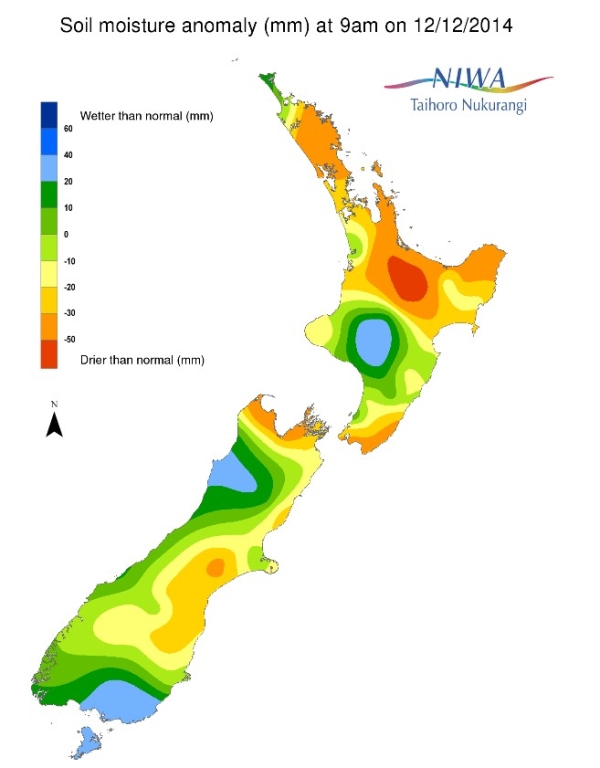Weekly update to help media assess likelihood of extremely dry weather preceding a drought. Regions experiencing severely to extremely drier than normal soils conditions are deemed “hotspots”.
Facts: Soil Moisture
For the North Island, soils continue to be much drier than normal (refer to figure below) for this time of year along eastern portions of the island. In particular, soil moistures in Whangarei, Kaipara, eastern Waikato, the Bay of Plenty as well as eastern parts of the Hawke’s Bay and Wellington regions are currently extremely drier than normal.
For the South Island, soil moisture levels also continue to be much drier than normal for this time of year for northern and eastern parts of the island. This includes the northern coasts of Tasman, Nelson and Marlborough where severely to extremely dry soils for this time of year exist. Soil moistures remain drier than normal for this time of year for much of eastern Canterbury.
Week-to-Week Comparison
When compared to this time last week, it is evident that soils in the northeast of the North Island have continued to dry out. Extremely drier than normal soils for the time of year persist in Kaipara, Whangarei, eastern Waikato and the Bay of Plenty, however, considerable rain forecast over the weekend and into Monday may help alleviate some of the dryness in these areas. Soil moisture levels in Manawatu-Whanagnui and along the Kapiti Coast have increased considerably since last week due to heavy rainfall midweek and are now in the normal to above normal range.
Soil moisture levels in the South Island are largely unchanged from last week. Despite plentiful rain mid-week over the northern parts of the island, soils remain drier than normal along the most northern parts of the island. Soils also remain severely drier than normal for parts of eastern Canterbury. Abnormally wet soils for this time of year persist for much central and southern Southland as well as southern portions of Otago and the Buller district.
Commentary
When considering the current soil moisture anomalies for this time of year, hotspots are present in northern Tasman, Nelson and Marlborough regions – slight improvement since last week. Hotspots also exist in much of eastern Canterbury and far northern Otago – little or no change since last week.
Immediately across the Cook Strait in the Wellington Region, South Wairarapa, Wellington City and Carterton are additional hotspot areas – with considerable improvement over the Kapiti Coast when compared to this time last week and little/no change for remaining aforementioned areas. For the rest of the North Island, hotspots include much of the eastern Waikato, Bay of Plenty and Gisborne regions as well as the districts pf Kaipara and Whangarei – with all of these regions experiencing a slight to modest worsening of soil moisture (drier conditions) when compared to last week.
For hotspot regions, sustained rainfall over several weeks is needed to return conditions back to normal. Additionally, if current conditions persisted, then drought conditions may be imminent.
Background:
Hotspot Watch a weekly advisory service for New Zealand media. It provides soil moisture and precipitation measurements around the country to help assess whether extremely dry conditions are imminent.
Soil moisture deficit: the amount of water needed to bring the soil moisture content back to field capacity, which is the maximum amount of water the soil can hold.
Soil moisture anomaly: the difference between the historical normal soil moisture deficit (or surplus) for a given time of year and actual soil moisture deficits.
Pictured below: Soil Moisture Anomaly Maps, relative to this time of year. On the left are values this time last week. On the right are the most recent values.


